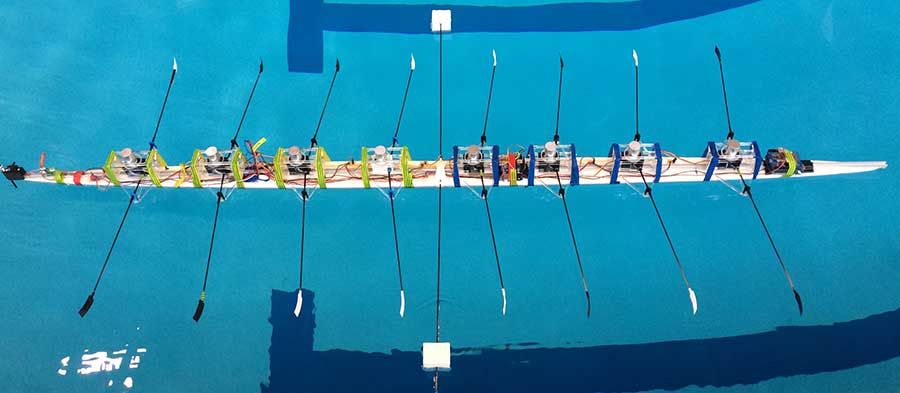
Photo: Romain Labbé
Robotic rowers test the effects of oar synchronization.
By Katherine Kornei
2016 APS Division of Fluid Dynamics Meeting — Competitive rowing is the epitome of synchronization: oars dipping into and out of the water at exactly the same instant, human bodies bending and pulling together. Now, scientists have examined the effect of removing some of that synchronization. A team of physicists found that the speed of a boat depended on whether or not its rowers were out of step. They expect that these results, presented at the 2016 APS Division of Fluid Dynamics annual meeting in November in Portland, Oregon, can be applied to improve rowing performance and optimize the design of boat propellers.
Romain Labbé and Jean-Philippe Boucher, two researchers from the Sport Physics group at Ecole Polytechnique in France, built a 1/10-scale model of a racing shell containing eight robotic rowers. "We wanted to look at the effect of synchronization on the boat speed, an effect that is emphasized with a large number of rowers," explained Boucher. Boucher and Labbé, along with Timothy Mouterde and Christophe Clanet, placed the 2-meter boat in the Ecole Polytechnique’s swimming pool and measured its speed as its robotic rowers moved in various degrees in synchronization.
When the robotic rowers dipped their 30-centimeter oars in the water at the same time — like competitive rowers do — the researchers found that the boat’s speed rose and fell by up to 20% every stroke. That’s like a car repeatedly losing and gaining 20 kilometers per hour on the highway. Real boats with human rowers also exhibit this same variation, which is caused by rowers all moving their bodies forwards and backwards together as they complete a rowing stroke. These speed fluctuations can significantly slow down a boat. "Large fluctuations in boat speed increase the friction on the hull," Boucher explained.
The team next investigated whether they could reduce these speed fluctuations. Inspired by nature, they instructed their robotic athletes to row asynchronously by not dipping their oars in the water at the same time. Some animals move their legs one after the other for propulsion, and the researchers wondered whether the same asynchronous movement might increase the speed of a rowing shell. "Shrimp swim in a desynchronized way probably to avoid fluctuations of speed and thus reduce the power dedicated to swimming," noted Boucher.
The researchers programmed each robot to row out of phase from its neighbors by one eighth of a rowing cycle. When they released the boat, they found that its speed fluctuations were roughly an order of magnitude lower than when the robots rowed synchronously. Asynchronous rowing reduces hull friction compared with rowing in synchrony, the authors noted, but asking human rowers to row like shrimp legs isn’t advisable. For starters, there’s the increased likelihood of clashing oars, a real possibility given that they’re nearly four meters long. Tangling oars can eject rowers from their seats, tumbling them into the water. Boucher and Labbé also showed that asynchronous rowing resulted in a lower average boat speed than synchronous rowing. The difference in speed — roughly 8% — is significant and translates into a margin of several boat lengths in a race. That’s an enormous distance considering that most elite rowing competitions are won by only a few seat lengths. "The overall balance between friction and propulsion makes the synchronous rowing mode the fastest," said Boucher. (In fact, there’s only one record of asynchronous rowing, which was attempted by a British rowing crew in 1929.)
To understand why synchronicity appears to be favorable, the researchers are now examining another aspect of rowing: the recovery stroke. This motion occurs when the rower moves his or her body opposite the direction of the boat’s movement while preparing to place the oar in the water again. It’s during this time that the boat slows down the most, but the motion is necessary to "reset" the rowers and allow them to take another stroke. The physicists are studying how changing the speed of the recovery stroke affects boat speed. Boucher and Labbé expect that their findings will lead to improved rowing techniques and more efficient propulsion through the water.
The author is a freelance science writer based in Portland, Oregon.
©1995 - 2024, AMERICAN PHYSICAL SOCIETY
APS encourages the redistribution of the materials included in this newspaper provided that attribution to the source is noted and the materials are not truncated or changed.
Editor: David Voss
Staff Science Writer: Rachel Gaal
Contributing Correspondent: Alaina G. Levine
Publication Designer and Production: Nancy Bennett-Karasik

